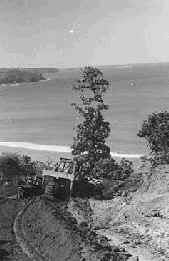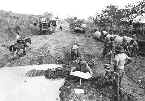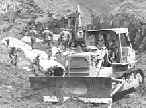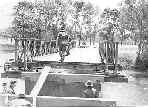One
of the most popular of the U.S. military’s programs in Latin
America and in the Caribbean in terms of having
significant impact on the local people in remote areas and economy
of many countries has been humanitarian engineering exercises conducted by active-duty military units
and tens of thousands of citizen-soldiers of the Army and Air
National Guard and Army, Air Force, Navy, and Marine Reserve
forces from all over the United States since 1984 under the aegis
of the U.S. Southern Command. Such exercises
(conducted under various names, primarily "Fuertes
Caminos/Strong Roads" and "Nuevos Horizontes/New
Horizons" are humanitarian and civil assistance missions
designed to provide meaningful real-world training for the
National Guard and Reserve forces as well as foster goodwill and improve relations between the
United States and the nations in the region.
BEGINNINGS
The genesis of this highly
successful military exercise program was due to the efforts of
General Paul Gorman, commander in chief of the U.S. Southern
Command (1983-1985) and his Army component commander, then
Brigadier General Fred F. Woerner, commanding general of the
193d Infantry Brigade (Panama) (1982-1986, later SouthCom
commander in chief (1987-1989). It was also the first major
expansion of the Army's new Partnership program implemented in
late 1979 calling for Army National Guard units to be paired with
active-duty Army units for training, exercises, and other
purposes. Southern Command's Army component -- 193d Infantry
Brigade (Panama) -- was one of the first Army units in this pilot
program and was paired with 53rd Infantry Brigade of the Florida
Army National Guard and the 92d Infantry Brigade of the Puerto
Rico Army National Guard in December 1979.
The first engineering exercise was
originally planned for Costa Rica in early 1984. However, the Costa Rican
national legislature did not approve the exercise (only a few
weeks before it was to begin) shortly after a U.S. official in
Washington, D.C., inadvertently used the term "combat engineers" in a
press conference explaining the exercise. Very shortly
thereafter, Panama agreed to host the exercise.
Thus the new exercise program --
the first unit-size engineering exercise and the first time Army
National Guard units deployed to Latin America -- began in late January
1984 in
Panama with the construction
of an initial part of a farm-to-market road in the western part of
Veraguas
Province in Panama, stretching from Mariato and Ponuga near the
Inter-American Highway south to Quebro and Arenas. About 750
members of the Puerto Rico Army National Guard and Florida Army
National Guard made up the Joint Task Force commanded by Colonel
William Navas of the Puerto Rico Army National Guard that
participated in the first phase. The road with 14 bridges
was completed in 1985 by about 10,000 Army National Guard
personnel principally from Puerto Rico and Florida National Guards
and other Guard units from several other states. Most of the
personnel rotated into Panama for their annual two-week Guard
training, with about 750 in Panama at any one time.
FIRST ENGINEERING
EXERCISE CONDUCTED IN LATIN AMERICA 1984-1985 IN PANAMA
 |

 |
| Forging
new road with bridges from Mariato south to Quebro on
western side of Veraguas Province in Panama 1984-1985 --
first road in that rural region. |

 |

CONGRESS
LEGISLATES HUMANITARIAN AND CIVIC ASSISTANCE PROGRAM
In 1985, Congress
authorized such assistance within the regional commands (such as
the Southern Command) to help build or repair a country's
infrastructure (e.g., roads, clinics, and schools) and provide
limited health care to rural populations. That action was
attributable in part to growing U.S. interest in events in Latin
America (including the insurgency in El Salvador and the Contra
war in Nicaragua) and in part to the civil war in
Afghanistan, The National Security Council asked the
Department of Defense (DoD) to study ways the U.S. military could
provide nonlethal assistance to factions believed to be in support
of democracy. The Secretary of Defense initiated a study that
concluded that DoD assistance for certain humanitarian assistance
activities would be appropriate (
"Role of the DoD in Humanitarian Assistance" Hearing,
House of Representatives Committee on Armed Services, April 19,
1994,Washington, DC: USGPO, 1995, p.50).
Establishing the Humanitarian and Civic Assistance (HCA) program
under Title 10, United States Code, Congress recognized the need
for an interagency approach to an essentially military program,
since clearly the aid provided went far beyond strictly military
relationships into sectors of civil society that were within the
purview of the Ambassador and the Department of State. The basic
law permitted military HCA under two conditions: the assistance
must advance the security interests of both the United States and
the host nation, and it must also enhance the operational skills
of the military members involved. Beyond that, to ensure
interagency planning, coordination and cooperation, the lawmakers
wrote guidelines mandating Secretary of State approval of HCA
activities in foreign countries and requiring that the HCA
complement (but not duplicate) other United States government
assistance, and that it meet the basic socio-economic needs of the
local populace. It provided for HCA, and the money that went with
it, for use in civilian projects only, specifically forbidding its
use for "…any individual, group, or organization engaged in
military or paramilitary operations. (From Text
of United States Code Title 10, Chapter 20, Section 401.)
The Southern Command
fully embraced HCA. It proved an effective, efficient way for
SouthCom to engage Latin American militaries, building up
bilateral relationships while meeting its stated theater strategic
objectives. The Command found that working in conjunction with an
allied nation's government to build needed infrastructure directly
contributed towards its objectives of strengthening democratic
institutions and supporting continued economic and social
progress. Working side by side with allied military engineers
and/or appropriate civilian agencies. United States military
engineers would demonstrate by their example the proper roles of
professional military forces in democratic societies. Extensive
use of citizen-soldiers of the U.S. National Guard of virtually
all the states and the Reserves over time further emphasized the
importance of that message.
These engineering
exercises conducted in Latin America and -- since July 1997 -- also
in the Caribbean area, like other Department of Defense exercises
conducted in the region, are directed by the U.S. Joint Chiefs
of Staff and sponsored by the Southern Command (based in Panama
until September 1997, in Miami since then). (Prior to 1997,
such exercises conducted in the Caribbean were sponsored by the
then U.S. Atlantic Command, headquartered at Norfolk, Virginia,
which until the 1996 change in the Joint Chiefs of Staff Unified
Command Plan, had operational responsibility for U.S. military
activities in that area.) Following
invitation by the host nation government through the U.S.
ambassador, each exercise is approved by the U.S. Department of
State, Department of Defense, and the host nation involved, and supports the
U.S. Ambassador’s Country Plan objectives in the host nation. (The
Director, Defense Security Cooperation Agency is the DoD approval
authority for all HCA projects coordinated through the
interagency.) Each such exercise must promote the security interests of both the
United States and the country in which the activities are to be
carried out; and the specific operational
readiness skills of the members of the armed forces who
participate in the activities.
This long-standing training
and humanitarian program has long represented an outstanding opportunity for the U.S. military and Reserve Component
(National Guard and Reserve) units to receive excellent real-world
training (the primary required objective from the U.S. perspective) in
planning for and deploying overseas and setting up and operating in
remote, austere areas, working closely with host nation
military and/or civilian government agencies in horizontal and
vertical construction projects, and redeploying to their home
stations after completion of the projects.. Medical specialists,
an integral part of such exercises, provide basic medical
care to the units involved in the exercise and help people who have compelling needs. Such
projects have touched the lives of thousands of people in remote
areas of Latin America and, more recently, also the Caribbean area
by opening remote areas to new markets (through farm-to-market
roads and bridges) and providing routine, but much needed
medical, dental, and veterinary services (the latter through
concurrent medical readiness training exercises).
Since 1984, more than 100,000
Reserve Component (Army and Air National Guards and Army,
air Force and Navy Reserves) and more than 10,000
active duty military personnel from throughout the United States and
(until
1997 some from Panama-based units) have rotated in and out of Latin
America to conduct engineering-oriented and related support
training, most of them for their two weeks of annual active duty
training. As a by-product of their training and construction
activities, new or repaired farm-to-market and other access roads
and new or repaired bridges, schools, medical clinics, sanitation
facilities and water wells are left for the benefit of the most
needy people
of the host nations involved.